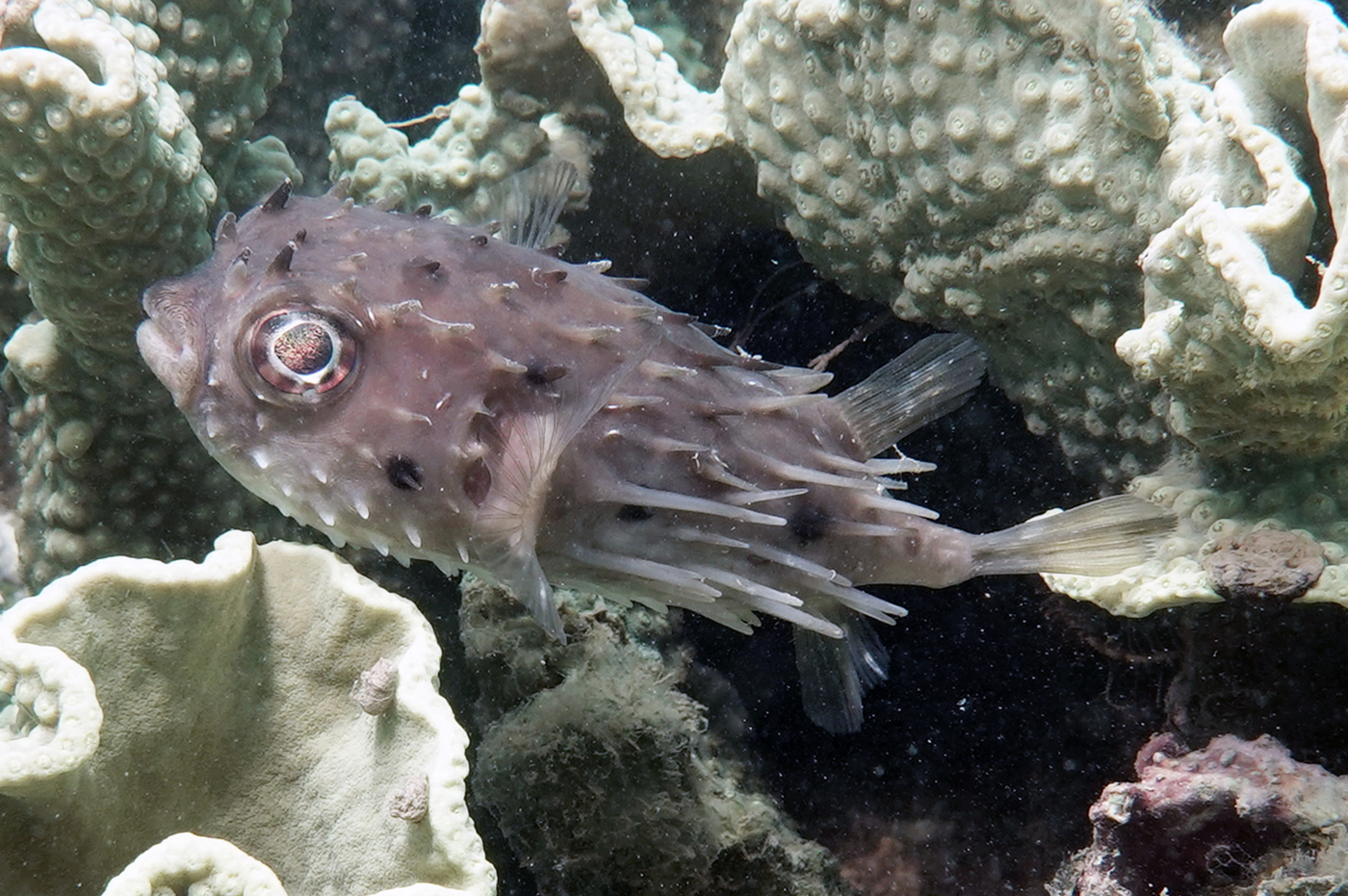Longspine Porcupinefish, Tragulichthys jaculiferus (Cuvier 1818)
Other Names: Green Porcupine-fish, Longspine Burrfish, Long-spined Porcupine-fish, Porcupine-fish, Red-eyed Porcupine Fish

A Longspine Porcupinefish, Tragulichthys jaculiferus, at Heron Point. Learmonth, Exmouth Gulf, Western Australia, November 2019. Source: Alex Hoschke / iNaturalist.org. License: CC by Attribution-NonCommercial
Summary:
A pale grey or brownish porcupinefish becoming whitish below, with several large black blotches or spots scattered on the head and side, and no spots on the fins.
Cite this page as:
Bray, D.J. 2022, Tragulichthys jaculiferus in Fishes of Australia, accessed 02 Jul 2025, https://fishesofaustralia.net.au/Home/species/782
Longspine Porcupinefish, Tragulichthys jaculiferus (Cuvier 1818)
More Info
|
Distribution |
Endemic to northern Australia, from the Houtman Abrolhos, Western Australia, around the tropical north to Moreton Bay, Queensland. The species does not occur in southern Australia or New Zealand. |
|
Features |
All spines fixed, except those in pectoral axil which are by far the longest on the body; all spines except those in the pectoral axil with 3 bases; spines long to medium; 9 caudal-fin rays; 19 vertebrae; no tentacles in adults; nostril in adult a short tube with 2 openings, but may become bifurcate in larger individuals; no spines wholly on dorsal surface of caudal peduncle, but large spines extend over the peduncle nearly to the caudal-fin base; no fins spotted; no large blotches on dorsal surface. |
|
Fisheries |
Taken and discarded as bycatch in commercial trawls. |
|
Etymology |
The specific name jaculiferus is derived from the Latin jaculum (= dart, javelin) and fero- (= to bear), in reference to the referring to numerous long sharp spines covering the body. |
|
Species Citation |
Diodon jaculiferus Cuvier 1818, Mémoires du Muséum national d'Histoire naturelle, Paris [1936-1950] 4: 130, pl. 7. Type locality: Seas of India (as 'Mers des Indes'). |
|
Author |
Bray, D.J. 2022 |
|
Resources |
Longspine Porcupinefish, Tragulichthys jaculiferus (Cuvier 1818)
References
Allen, G.R. & Swainston, R. 1988. The Marine Fishes of North-Western Australia. A field guide for anglers and divers. Perth, WA : Western Australian Museum vi 201 pp., 70 pls.
Cuvier, G.L. 1818. Sur les diodons, vulgairement orbes épineux. Mémoires du Muséum national d'Histoire naturelle, Paris [1936-1950] 4: 121-138 2 pls See ref at BHL
Gloerfelt-Tarp, T. & Kailola, P.J. 1984. Trawled Fishes of Southern Indonesia and Northwest Australia. Jakarta : Dir. Gen. Fish. (Indonesia), German Tech. Coop., Aust. Dev. Ass. Bur. 406 pp.
Hutchins, B. 2004. Fishes of the Dampier Archipelago, Western Australia. Records of the Western Australian Museum, Supplement 66: 343–398
Johnson, J.W. 2010. Fishes of the Moreton Bay Marine Park and adjacent continental shelf waters, Queensland, Australia. pp. 299-353 in Davie, P.J.F. & Phillips, J.A. Proceedings of the Thirteenth International Marine Biological Workshop, The Marine Fauna and Flora of Moreton Bay. Memoirs of the Queensland Museum 54(3)
Larson, H.K., Williams, R.S. & Hammer, M.P. 2013. An annotated checklist of the fishes of the Northern Territory, Australia. Zootaxa 3696(1): 1-293
Larson, H.K. & Williams, R.S. 1997. Darwin Harbour fishes: a survey and annotated checklist. pp. 339-380 in Hanley, H.R., Caswell, G., Megirian, D. & Larson, H.K. (eds). The Marine Flora and Fauna of Darwin Harbour, Northern Territory, Australia. Proceedings of the Sixth International Marine Biology Workshop. Darwin : Museum and Art Gallery of the Northern Territory 466 pp.
Leis, J.M. 2001. Diodontidae. pp. 3958-3965 in Carpenter, K.E. & Niem, T.H. (eds). The Living Marine Resources of the Western Central Pacific. FAO Species Identification Guide for Fisheries Purposes. Rome : FAO Vol. 6 pp. 3381-4218.
Leis, J.M. 2006. Nomenclature and distribution of the species of the Porcupinefish family Diodontidae (Pisces, Teleostei). Memoirs of Museum Victoria 63(1): 77-90 http://doi.org/10.24199/j.mmv.2006.63.10
Marshall, T.C. 1964. Fishes of the Great Barrier Reef and Coastal Waters of Queensland. Sydney : Angus & Robertson 566 pp. 136 pls.
Ogilby, J.D. 1910. On new or insufficiently described fishes. Proceedings of the Royal Society of Queensland 23(1): 1-55 (described as Chilomycterus grandoculis, type locality Moreton Bay, Qld)
Ramm, D.C., Pender, P.J., Willing, R.S. & Buckworth, R.C. 1990. Large-scale spatial patterns of abundance within the assemblage of fish caught by prawn trawlers in Northern Australian waters. Australian Journal of Marine and Freshwater Research 41(1): 79-95.
Randall, J.E., Allen, G.R. & Steene, R. 1990. Fishes of the Great Barrier Reef and Coral Sea. Bathurst : Crawford House Press 507 pp. figs.
Randall, J.E., Allen, G.R. & Steene, R. 1997. Fishes of the Great Barrier Reef and Coral Sea. Bathurst : Crawford House Press 557 pp. figs.
Russell, B.C. & Houston, W. 1989. Offshore fishes of the Arafura Sea. The Beagle, Records of the Museums and Art Galleries of the Northern Territory 6(1): 69-84
Sainsbury, K.J., Kailola, P.J. & Leyland, G.G. 1984. Continental Shelf Fishes of Northern and North-Western Australia. Canberra : Fisheries Information Service 375 pp. figs & pls. (as Cyclichthys jaculiferus)
Travers, M.J., Potter, I.C., Clarke, K.R., Newman, S.J. & Hutchins, J.B. 2010. The inshore fish faunas over soft substrates and reefs on the tropical west coast of Australia differ and change with latitude and bioregion. Journal of Biogeography 37(1): 148-169 https://doi.org/10.1111/j.1365-2699.2009.02183.x
Tyler, J.C. 1980. Osteology, phylogeny, and higher classification of the fishes of the order Plectognathi (Tetraodontiformes). NOAA Technical Report NMFS Circular No. 434: i-xi + 1-422. https://doi.org/10.5962/bhl.title.63022
Whitley, G.P. 1931. Studies in Ichthyology No. 4. Records of the Australian Museum 18(3): 96-133 figs 1-2 pls 11-16






